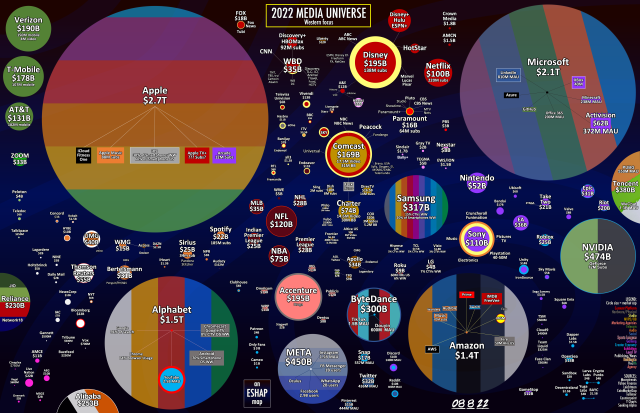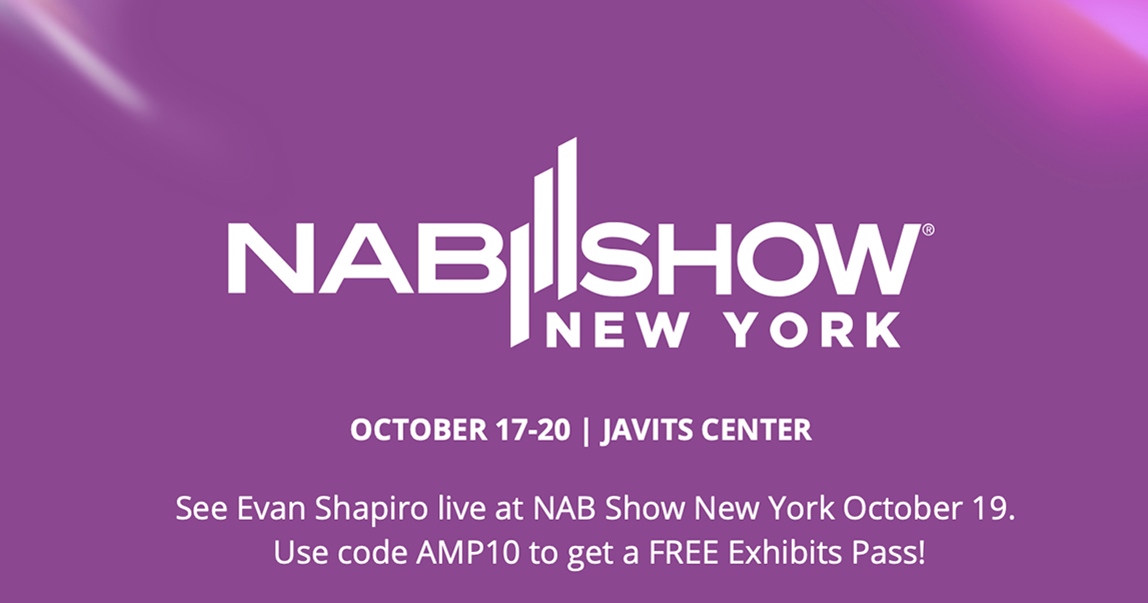This video is the first in a new series of conversations with people shaping the media and entertainment industry. In this conversation, Emily and Evan had a lot of ground to cover in fewer than 20 minutes, discussing everything from gaming’s significance in M&E to Web3 to how not to be caught off-guard when the world is changing so rapidly.
Evan Shapiro is an award-winning producer, professor, and media thought leader. Among his many projects is the Substack newsletter Media War & Peace, which explores the state of the ever-expanding and -contracting world of media and entertainment.
Shapiro will be the keynote speaker for NAB Show New York, Oct. 17-20, at the Javits Center. His address, “Bringing Media Into the Current Century, Now,” is scheduled for 10:30 a.m. on Wednesday, Oct. 19, which is the first day the exhibit hall is open.
Ahead of his NAB Show New York appearance, Emily Reigart caught up with Shapiro to get a sense of what he thinks matters for media in Q4 2022.
Understanding and Illustrating the Media Universe
The “four major segments of the media economy are audio, video, gaming and social. And each one of them has a tremendous amount of evolution to do in the next number of years to be prepared for what’s coming next,” Shapiro says.
Shapiro’s recent internet virality stemmed from his role as a media prof. He wanted to create a tracker to illustrate changes in the M&E landscape for a Fordham University course on media studies. The PowerPoint-based dashboard helped Shapiro discover an “Aha!” moment: a handful of companies are dominating the media universe, and their gravitational orbit is consuming more market share all the time.
Shapiro calls the biggest players in M&E “multinational, trillion-dollar death stars.”

It may surprise people that Silicon Valley’s tech giants dominate this map, but Shapiro points out that “these large tech companies have taken over the infrastructure of media.” In 2022, smartphones are the medium through which many consume media, so Apple and Google automatically have a leg up, in a world in which they “control 100% of the smartphone operating system market on the planet.”
Large tech companies have taken over the infrastructure of media.
Evan Shapiro
“When you look at that map and you see companies like Apple and Amazon or NVIDIA on there, it’s because they’re so wound inside the content that we’re consuming, it’s hard to separate them from it.”
Another, maybe, surprising presence is Accenture. Shapiro explains, “They started as an accounting firm, they are now heavily invested in media insights, media analytics, media backend, and also one of the largest advertising agencies on the face of the earth.”
In addition to literally owning the playing field, Apple and Google “have invested a tremendous amount more becoming media companies themselves.” Amazon’s certainly no slouch either, with its empire of dongles and devices. More on them later.
He says these companies are well positioned to challenge the “traditional media giants” (Disney, Viacom, Netflix, etc) because they don’t specialize in only one media sector. Which is smart, since the shifting sands of consumer trends can make for uneven footing.

Gaming Can’t Be Ignored
In 2022, “Gaming is actually the largest segment of media,” Shapiro points out, “and it surpassed video in 2021 as a percentage of the overall media economy.”
Amazon-owned “Twitch is the largest video live playing platform on Earth. It is the ESPN meets BBC meets CNN of gaming.”
Gaming is actually the largest segment of media.
Evan Shapiro
“And then you look at things like Sonic the Hedgehog and the Witcher, all of these ancillary IP explorations that have driven off of game culture and gaming itself. I think it’s really not smart to avoid gaming and social media as huge segments of the media economy.”
Lifestyle Bundles Are the Next Cable Package
The future is “going to be very difficult for single purpose content entities, whether that’s social media, gaming, audio or video.” So how do these companies overcome current challenges and evolve to compete successfully?
Consider that in 2022, “everything is media. When your shopping network is airing Thursday Night Football, and when your news is aggregated through your phone, pretty much all tech really invades the media ecosphere, and media becomes really a piece of software in a larger tech game.”
That [home] bundle was destroyed by streaming, and it’s being replaced by what I like to call a lifestyle bundle.
Evan Shapiro
“We went from an era where the TV bundle, bundles of channels and then the home bundle; video, broadband and phone really protected the entire television ecosystem.” (How many people kept their landline to keep the cost of broadband down?)
But nothing lasts forever. Shapiro says, the home “bundle was destroyed by streaming, and it’s being replaced by what I like to call a lifestyle bundle or a Maslow’s bundle — shopping, discounts at Whole Foods, Thursday Night Football, books, audio, all of this stuff bundled into a larger package.” (Yes, he’s listing benefits of the Amazon Prime ecosystem as of autumn 2022).
Going forward, Shapiro predicts, Spotify, Meta, Netflix and Nintendo will “have very difficult times competing with multifaceted big tech fly wheels, who can lose money in any one of those segments in order to steal share, and then bundle it in to a larger suite of services that they sell as part of a hardware offering.”
Yep. You read that right: physical products will still matter in the 2023 economy. Apple’s media plays, the Apple One content bundle, even sponsoring the Super Bowl LVII Halftime Show and booking Rihanna? According to Shapiro, all these moves are ultimately “just side hustles for the iPhone.”
However, that last one (combined with the launch of podcast subscription service in 2021) is a red flag announcing Apple’s intentions to get serious about audio. Again, keep in mind that the “second largest music subscription platform on the face of the planet” hasn’t been trying that hard yet. Apple is coming for you, Spotify.
Don’t forget how Apple decimated online advertising in 2021. “Apple basically put Facebook out of the advertising business with their privacy changes and just destroyed a tremendous amount of value and revenue generation in social media. So they went right at social media, a big segment of the media economy.” Looks like audio could be the next victim.
However, Shapiro isn’t convinced that the same outcome is inevitable. To stay in the game, Spotify needs a smart partner to help insulate it. Podcasts and music alone will not save you. Shapiro highlights the Spotify-Hulu college discount program as a successful relationship they could/should build upon.
Regardless, “that type of asymmetrical, other type of benefit to the subscription package is going to be table stakes, starting in 2023. You cannot just offer one content vertical anymore and hope to keep subscribers around,” Shapiro advises.
Web3 Is Definitely… Something
There are still many Web3 skeptics, but Shapiro isn’t among them. Well, maybe that’s not quite fair.
Shapiro says we’re currently in the AOL era of Web3, equivalent perhaps to the period before AOL bought Time Warner. (Remember the internet before January 2000? Not all that great, in retrospect.)
Shapiro believes in the potential of Web3, but isn’t buying all of the hype around it. He specifically calls out the buzz around NFTs, an easy target after the valuation rollercoaster that was 2022.
After all, he points out, “If you pay attention to the stupidest stuff that is done with the new technology, we would’ve ignored the internet; we would’ve ignored the phone; we would’ve ignored the car.“
But it’s the technology underpinning Web3 that’s truly game-changing. Web3’s foundation is on blockchain.
Blockchain’s potential to change how we protect intellectual property, via smart contracts, is an obvious example of how Web3 will improve creators’ lives and livelihoods. Shapiro predicts blockchain-based IP protection “will probably be as important to content creation — and not just the written word and music and cartoons and movies, but also architecture and chemical compounds and design — probably as important to content as the movable type.”
If you pay attention to the stupidest stuff that is done with the new technology, we would’ve ignored the internet; we would’ve ignored the phone; we would’ve ignored the car.
Evan Shapiro
Another hallmark of Web3 is the shift to a more fair use of consumer data.
In Web2, users were, unwittingly, the product. In Web3, consumers will trade their data and privacy intentionally and derive benefits from those digital exchanges. Ownership of your online presence and activity will be more transparent.
Something New — But Try to Avoid Surprises
How does Shapiro keep on top of all this industry change? And even more challenging, how does he figure out what’s coming next?
“The rate of change has accelerated to the point where we don’t notice it anymore. It’s happening all around us all the time,” Shapiro says. So he is intentional about paying attention to these shifts.
Shapiro’s daily routine begins with two hours dedicated to learning “something new about something new” via an hour each of reading and writing in order to combat the rate of change. “If you wake up and try to re-chart your brain around your ecosystem on a daily basis, trying to learn something new about something new every day, it’s very difficult to be taken by surprise.”
He also advisers us to “pay attention to the data.” Take the Netflix stockpocalypse, for example.
Shapiro explains, “Netflix’s numbers were shitty for a year prior to the first quarter of this year. Their earnings call was just the culmination of something; it wasn’t the start of something. Those of us who had been asking about their churn for some time knew that there was going to be some sort of reckoning coming.”
Incremental changes add up fast in the 21st century.
NAB Show Announces Call for Proposals for 2023 Event

By Amplify Content Team
Bring your expertise and thought leadership to the world’s largest broadcast, media and entertainment trade show! If you have a success story, exciting case study or an amazing project to share, NAB Show wants to hear from you. Celebrating 100 years of innovation in 2023, NAB Show organizers are on a quest to populate the conference and floor theater stages with the best of the best.
Encompassing the entire content lifecycle, NAB Show 2023 will focus on 28 distinct topics and trends, including everything from Audio and Sound, Cinematography and Lighting, and Editing, Post-Production and VFX to Data and Analytics, Advertising and Monetization, and Multiplatform Content Delivery, as well as Virtual and Remote Production, Metaverse, VR and Immersive Experiences, and Web3, Blockchain and NFTs.
Session formats under consideration are limited to Fireside Chats, Interactive Q&As, Tech Demos, Panels, Case Studies and Success Stories, and Original Research. Proposals promoting company products or services will not be considered; however, proposals explaining the underlying technologies used in broadcast products or services will be considered. Proposals must be submitted by Nov. 4. Submitters will be notified of their status by Friday, Dec. 23.
NAB Show is also accepting abstracts from manufacturers, service providers, vendors, exhibitors and sponsors for paid thought leadership opportunities both on the floor and in conference programs at the show, as well as papers for inclusion in the 2023 Broadcast Engineering and IT (BEIT) Conference at NAB Show.
For more information and submission guidelines, visit www.nabshow.com.

